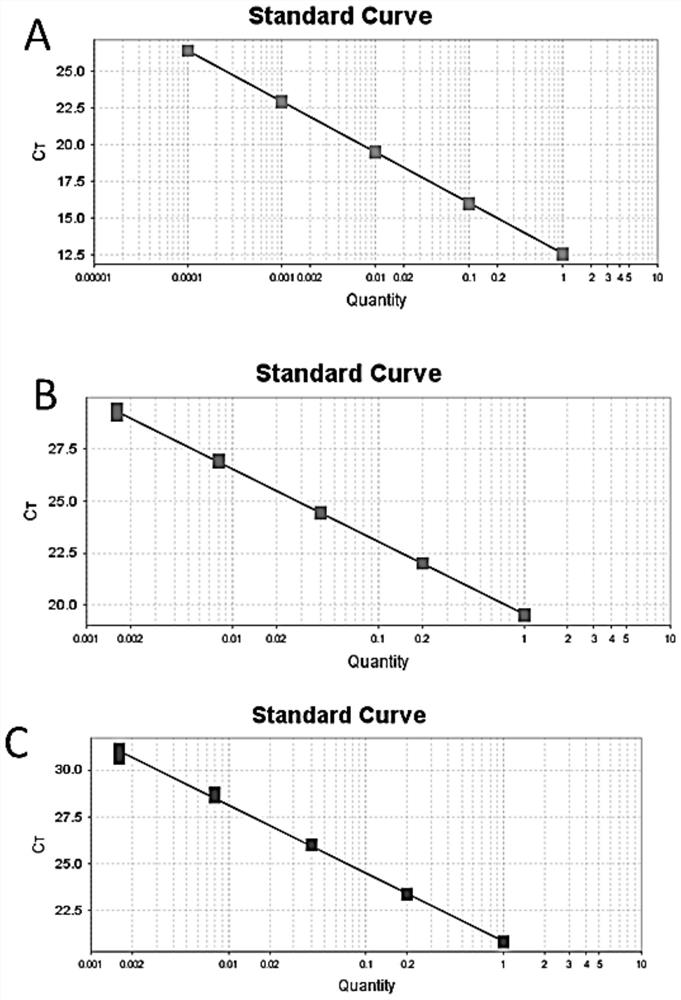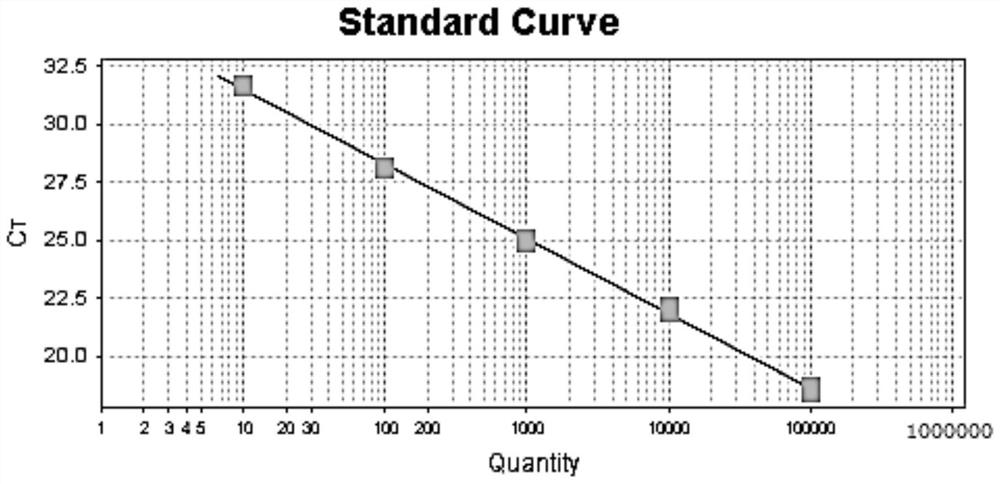Universal method for detecting copy number of target gene and titer of virus and application
A technology of gene copy number and virus titer, applied in biochemical equipment and methods, microbial determination/inspection, DNA/RNA fragments, etc. and other problems, to achieve the effect of good stability and repeatability, ensuring accurate amplification and ensuring accuracy
- Summary
- Abstract
- Description
- Claims
- Application Information
AI Technical Summary
Problems solved by technology
Method used
Image
Examples
Embodiment 1
[0049] Example 1 The versatility of PCBP2 in the detection of copy number by PCR SYBR dye method
[0050] The 144 nucleotides at positions 12623-12766 of the PCBP2 gene (Gene ID: 5094) are shown in SEQ ID: NO 1, and the 104 nucleotides at positions 22951-23054 are shown in SEQ ID: NO 2. Design two pairs of primers, as shown in the table below.
[0051]
[0052] Plasmid extraction
[0053] Add an appropriate amount of tissue lysate and proteinase K to the cell sample, incubate the cell sample at 55°C overnight for digestion and lysis; then use RNase and 5M NaCl solution to remove the protein, transfer the supernatant to a new 2ml centrifuge tube; add pre-cooled anhydrous Precipitate DNA with ethanol; discard supernatant after DNA precipitation, add 70% ethanol to remove salt ions, resuspend and dissolve DNA with TE buffer, store at 4°C for short term or -20°C for long term.
[0054] genome extraction
[0055] Add appropriate amount of tissue lysate and proteinase K to hum...
Embodiment 2
[0061] Example 2 Universality of PCBP2 in copy number detection by single-plex PCR TaqMan probe method
[0062] 1) The 144 nucleotides at positions 12623-12766 of the PCBP2 gene (Gene ID: 5094) are shown in SEQ ID: NO 1, and the 104 nucleotides at positions 22951-23054 are shown in SEQ ID: NO2 To design primer and probe, described primer adopts the primer of embodiment 2, and the nucleotide sequence of described probe is as shown in SEQ ID: NO 7.
[0063]
[0064] 2) Plasmid extraction
[0065] Add an appropriate amount of tissue lysate and proteinase K to the cell sample, incubate the cell sample at 55°C overnight for digestion and lysis; then use RNase and 5M NaCl solution to remove the protein, transfer the supernatant to a new 2ml centrifuge tube; add pre-cooled anhydrous Precipitate DNA with ethanol; discard supernatant after DNA precipitation, add 70% ethanol to remove salt ions, resuspend and dissolve DNA with TE buffer, store at 4°C for short term or -20°C for long...
Embodiment 3
[0073] Example 3 Detection of lentivirus titer
[0074] 1) The prepared virus infected CHO cells (mouse ovary cell line), and the genome was extracted after 72 hours of infection, and 10 different transduced virus samples were obtained, respectively numbered: 174, 205, 206, 207, 209, 215, 216 , 80, 87 and 89, using the multiple TaqMan probe method, determine the virus titer, analyze the data with analysis software, calculate the virus titer according to the standard curve, virus titer=(number of cells*copy number / cell) / add virus The amount of the results expressed in TU / mL.
[0075] 2) The traditional method without internal reference, CDKN1A as internal reference and PCBP2 as internal reference were respectively used to detect 17 virus samples transduced into CHO cell lines, and the differences between different methods were compared, and finally it was found that PCBP2 was used as internal reference to detect The virus titer of the mouse-derived sample is superior to the cu...
PUM
 Login to View More
Login to View More Abstract
Description
Claims
Application Information
 Login to View More
Login to View More - R&D
- Intellectual Property
- Life Sciences
- Materials
- Tech Scout
- Unparalleled Data Quality
- Higher Quality Content
- 60% Fewer Hallucinations
Browse by: Latest US Patents, China's latest patents, Technical Efficacy Thesaurus, Application Domain, Technology Topic, Popular Technical Reports.
© 2025 PatSnap. All rights reserved.Legal|Privacy policy|Modern Slavery Act Transparency Statement|Sitemap|About US| Contact US: help@patsnap.com



